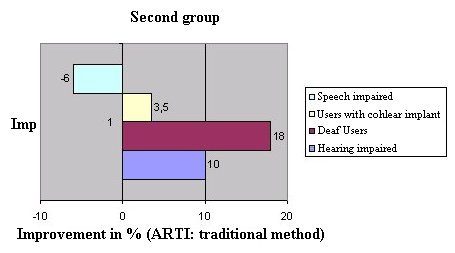

Hungarian
Slovenian
Evaluation
The evaluation project was started when the SPECO program and the User Manual were com-pleted. Then the program was given to the teachers.
Two types of the evaluation were prepared: a qualitative and a quantitative one.
Qualitative evaluation was based on the answers of the therapists that worked with the SPECO System during three months or half a year. They filled in a special questionnaire con-structed by the coordinator as follows:
| Name: |
| Job: |
| How long have you been using the program? |
| How good Do you find this method from pedagogical point of view? |
| Does the user manual give orientation enough? |
| Is any special skill necessary to the usage of the program? |
| Is the training a pleasure for the children? |
| Do children understand the feedback in the program? |
| Are pictures understandable in the exercises "isolated sound"? |
| Are the speech pictures inderstandable for children in the exercises of síllables, words and sentences? |
| Is more training possibility necessary during the exercises? |
| Is less training possibility enough during the exercises? |
| Would any other kind of training possibilities be useful? |
| If yes, which ones? |
| What is your opinion about the exercises? |
| Have exeercises developed the speech of the children? In what? |
| Was it difficult to work with the program? If yes, please explain. |
| How long did it take for a phoneme in isolation to form perfectly? |
| How long did it take for a phoneme in continuous speech to form perfectly? |
| What is the difference from traditional therapy? |
| Did you like this method? |
| Any other ideas? |
The Hungarian, Slovenian, Swedish and English partners, prepared qualitative evaluation. In general, the therapists were very satisfied with this method of learning. The summarised opinion of the teachers in case of all languages was very good. The developed method of learning is very useful, especially as supplement and variegation to classical methods. It is a very welcome modification in the work, pleasant for children and useful in the therapy of many speech and hearing disturbances. The level of good usage de-pends on the therapists. From pedagogical point of view it is very highly rated. The user manual gives therapists enough help and information, although they used only the initial ver-sion of the manual. According to their opinion there is no need for additional exercises, the usage of the program is successful. Children show a lot of interest and love to work with the program. They quickly understood the feedback. The program and the pictures are understandable enough for usage. In general, the opinion of the therapists is that the program stimulates children, provides audio and visual presentation, and good visual control. Program also stimulates longer attention in exercises. Quantitative evaluation was based on the comparison of the intelligibility development of the children trained by the SPECO program, and by the traditional method (control groups). Quantitative evaluation was prepared by the Slovenian and Hungarian partners. We examined different speech handicapped groups as follows: 1) severely hearing-impaired children (sign language), 2) hearing-impaired children (spoken language), 3) deaf children, 4) children with cochlear implant and 5) normal-hearing children with difficulties in speaking and understanding a language. Hungarian pupils were trained for half a year while the Slovenians only for 3 months.
|
|
|
|
Hungarian |
Slovenian |
The effect of the speech therapy
The Hungarian experiment shows much more intensive indelibility development in case of all groups trained by the SPECO system than in case of the traditional therapy. In case of the Slovenian pupils unambiguously the pupils trained by the SPECO system improved more, but in the case of normal hearing, and cochlear implant the result was not so unambiguous. 3 months training is too short to imitate such a new system. The Hungarian teacher worked with the old version of the speech corrector, so she had much more practice in the usage of the computer based tools. Summarizing the quantitative evaluation we can tell that SPECO System is a useful tool for speech training. It helps the work of the teachers. The level of good usage depends on the therapist. It was found that a consistently shorter period of time was required for improving a speech sound than was the case with corresponding children of similar mental ability and impairment level who had been instructed by the traditional method. However, it is difficult to express the results in quantitative data because the result depended on many other factors (for example, one highly important factor was how much additional help the child received at home). This tool is a good aid because it helps the work of the therapist and gives variety to teaching. On the other hand, at the automation-phase or in case of elder children, the visual tool itself gives a good possibility to practice alone.
Created on November 28, 2001